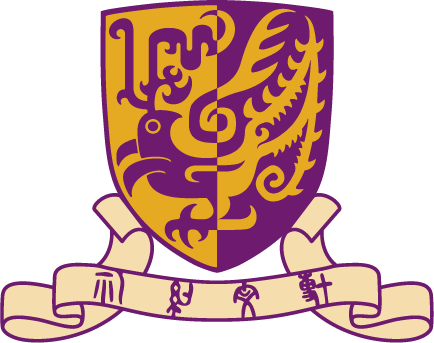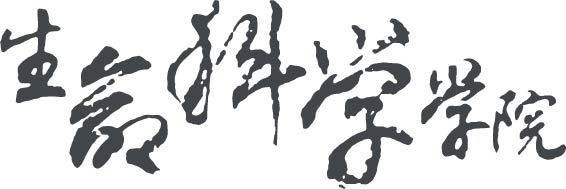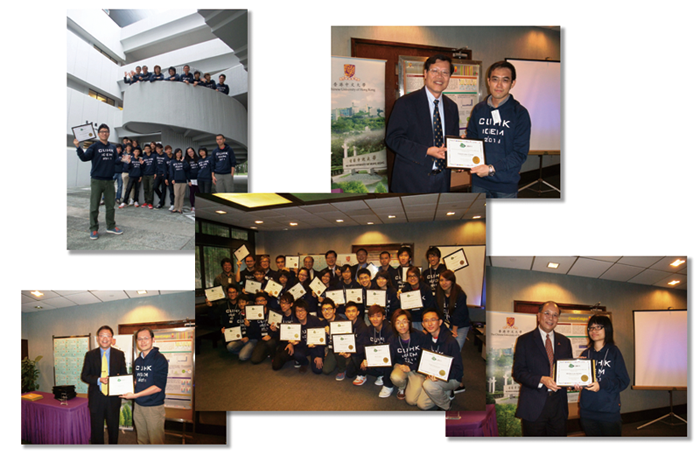|
*********************************************************************** CUHK Undergraduate Students Win Gold Medal at iGEM Asia A genetic engineering team formed by undergraduate students of science and engineering at The Chinese University of Hong Kong (CUHK) recently won a gold medal at the iGEM (international Genetic Engineered Machine) Asia Regional Jamboree. They also won the Best BioBrick Measurement Approach and the Best New BioBrick Part (Natural) awards and were qualified to participate in the world championship of the iGEM Jamboree to be held at the Massachusetts Institute of Technology (MIT) in November, competing with over 50 teams from around the world. Prof. Ng Cheuk-yiu, Dean of Science; Prof. K.F. Wong, Associate Dean of Engineering; and Prof. Chu Ka-hou, Director of School of Life Sciences, today (25 October) presented certificates to the winning students in recognition of their outstanding performance. The CUHK team comprises seven coaches and 24 undergraduate students, including 19 life sciences students, four engineering students and one chemistry student. This is the second year that CUHK students have participated in the competition. While participants last year were all from the School of Life Sciences, engineering students from Biomedical Engineering, Computer Science and Engineering and Electronic Engineering also joined the competition this year to conduct interdisciplinary synthetic biological research. With the theme of renewable energy, the CUHK team studied how the use of solar energy could solve certain problems in two major environmental issues: water and energy. Based on the idea that a bacterial halorhodopsin can use solar energy to drive the transport of chloride ion across the membrane, the team used sunlight to drive the ion channel to concentrate ion or desalt seawater for freshwater production and create electric current to produce electricity simultaneously. The students' work was greatly acclaimed by the panel of judges. One of the judges, Prof. Mukund Tattai of the National Centre for Biological Sciences (India), who presented the team with the Best BioBrick Measurement Approach award, commented that the team had done extensive characterizations to the BioBrick which is well ready for use by the research community. Another panel judge, Prof. Qi Ouyang of Peking University, who presented the team with the Best New BioBrick Part (Natural) award, commended the team's creativity in making use of an ion transporter found in bacteria to generate electricity. This is the first time that regional competitions of iGEM have been held in the US, Europe and Asia. A total of 42 teams from different universities joined the competition in Asia. Since this May, the CUHK team had been devoted to preparing for the competition and developed the project completely by themselves, from defining themes, designing experiments to developing new parts, models and biobricks from scratch. They demonstrated ample team spirit and efforts included publishing a wiki page, producing posters and introducing the project and the new devices on public occasions. Prof. Chu Ka-hou emphasized that experiential learning beyond classroom was very important in nurturing talents. During the competition, students not only got an opportunity to show their creativity, but also learned the basic experimental skills through making biobricks or software. It also helped enhance their team spirit and time management skills. A biochemistry student, Gordon Chan, said, 'iGEM offers us a rare opportunity to use some state-of-the-art technological instruments and polish skills that are beyond the formal curriculum, including experimental techniques, writing skills, leadership skills, social skills, statistical analysis and presentation skills. The heavy workload also trained up my perseverance.' About iGEM Competition iGEM is an annual premier synthetic biology competition for undergraduates worldwide. It was established by the MIT in 2004 to foster students' learning in synthetic biology, promote collaboration among students and nurture biology talents. Participating teams are required to specify, design, build, and test simple biological systems made from standard, interchangeable biological parts. The accomplishments of these student teams often lead to important advances in medicine, energy, and the environment. For more information, please visit http://www.igem.org. 由香港中文大學(中大)理學院及工程學院本科生組成的基因工程隊伍日前在國際遺傳工程機器設計競賽(iGEM)的亞洲區比賽中榮獲金獎,並同時獲頒最佳生物新天然零件及最佳零件實驗量度兩項大獎,取得晉身世界賽的入場券,將於下月赴美國麻省理工學院參加iGEM決賽,與全球五十多隊隊伍一較高下。中大理學院院長伍灼耀教授、工程學院副院長黃錦輝教授和生命科學學院院長朱嘉濠教授今天(10月25日)頒發獎狀予各得獎同學,並讚揚他們的傑出表現。 中大隊伍由七名教練及廿四名同學組成,包括十九名生命科學學院的學生、四名工程學院學生及一名化學系學生。中大生命科學學院去年首度參賽,今年更首度加入工程學院的學生,他們分別來自生物醫學工程學課程、計算機科學與工程學系和電子工程學系,與理學院學生一起進行跨學科的合成生物學研究。中大隊伍的參賽項目以再生能源為題,使用太陽能改善水源和能源兩大環境問題。基於細菌內的感光離子通道可透過太陽能來輸送氯離子,中大隊伍開發的項目利用太陽光照促使細菌吸收離子,一方面吸走水中鹽份有助海水化淡,同時可產生電流來發電。 評審小組對中大的項目讚賞不已,來自印度國立生物科學中心的達泰牧艾教授在頒發最佳零件實驗量度大獎時表示,中大隊伍所開發的生物零件經過同學的詳細分析後,現已適合提供給其他研究人員使用。另一評審,來自北京大學的歐陽頤教授在頒發生物新天然零件大獎時,特別讚揚使用細菌感光離子通道來發電的構思十分具創意。 今年,賽會首次在美洲、歐洲及亞洲舉辦iGEM分區賽,亞洲區共有四十二隊來自不同大學的隊伍參賽。中大隊伍自今年五月起積極籌備比賽,由訂定題目、設計實驗,到創造生物零件、模型及化學零件,皆完全由同學自行構思。隊員分工合作,既順利完成了實驗,還在互聯網上發表維基網頁、印製海報,並在公開演說中講解其構思的課題及創作的新零件。 朱嘉濠教授強調,課堂以外的學習經歷對培養人才十分重要,是次比賽為同學提供發揮無限創意的空間,讓他們在親自製作生物零件或編寫軟件的過程中學會基礎實驗的技術,更實踐了時間管理及團隊精神。來自生化課程的陳灝晴同學表示:「iGEM比賽讓我有機會使用一般本科生難以接觸到的嶄新科技儀器和技術,還可學習到多項課程外的技巧,如做實驗、寫作、領導能力、社交、統計分析、表達技巧等;繁重的工作量亦使我的毅力得到很好的鍛鍊。」 iGEM比賽簡介 iGEM比賽為國際合成生物學界每年一度的盛事,專為本科生而設。iGEM由麻省理工學院於2004年創立,旨在促進學生在合成生物學的學習、交流與合作,以培養合成生物學人才。比賽隊伍須利用基本且可交替的生物部件,設計及建立有效的生物系統。參賽作品水平超卓,有效推動醫學、能源及環境等方面的發展。網址:http://www.igem.org。 |
|
|
>> iGEM CUHK Team website |
| >> Team Members |
| >> More Photos |




